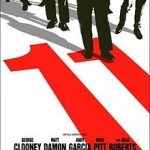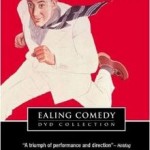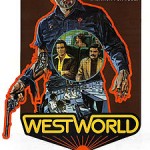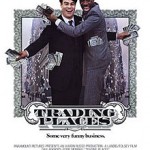 As a golden oldie for late night entertainment with a group of youngsters, Ocean’s Eleven, Stephen Soderberg’s 2001 remake of Lewis Milestone’s 1960 rat pack original, is a fair-to-middle-ing option, a super-heist movie with a super cast, topped by George Clooney, who robs a high security vault and gets beaten up without ever a hair being out of place – but that’s super-stardom for you. Because I have been reading Robert D. Hare’s book about psychopathy, Without Conscience, I couldn’t help but recognise the symptoms in Danny Ocean (Clooney’s character): glib and superficial; egocentric and grandiose; lack of remorse or guilt; deceitful and manipulative; need for excitement; lack of responsibility… Danny Ocean ticks off more than a few of the tell-tale symptoms on Hare’s psychopathy checklist. I shall do a separate post about Hare’s book in due course, but I have been deeply impressed by the apparent ubiquity of the condition, which does not necessarily lead to morally compromised roles such as the one Clooney plays.
As a golden oldie for late night entertainment with a group of youngsters, Ocean’s Eleven, Stephen Soderberg’s 2001 remake of Lewis Milestone’s 1960 rat pack original, is a fair-to-middle-ing option, a super-heist movie with a super cast, topped by George Clooney, who robs a high security vault and gets beaten up without ever a hair being out of place – but that’s super-stardom for you. Because I have been reading Robert D. Hare’s book about psychopathy, Without Conscience, I couldn’t help but recognise the symptoms in Danny Ocean (Clooney’s character): glib and superficial; egocentric and grandiose; lack of remorse or guilt; deceitful and manipulative; need for excitement; lack of responsibility… Danny Ocean ticks off more than a few of the tell-tale symptoms on Hare’s psychopathy checklist. I shall do a separate post about Hare’s book in due course, but I have been deeply impressed by the apparent ubiquity of the condition, which does not necessarily lead to morally compromised roles such as the one Clooney plays.
Category: Activities (page 3 of 37)
 Today I watched Stanley Donen’s 1980 science fiction thriller, Saturn 3, not for its good reputation but, actually, the reverse. The screenplay was written by novelist Martin Amis – his only such venture. He would later claim that not much of his original screenplay survived and used this as an alibi for, despite featuring a strong cast – Kirk Douglas, Farrah Fawcett, Harvey Keitel – the film was, as they say, not a critical success. It is, at least, an interesting exercise in what might have been. Douglas’s performance never quite gels. Farrah Fawcett is demeaned as a frail, frequently screaming beauty (the contrast with Sigourney Weaver’s role in Alien, screened just the year before, is stark) and, strangely, Harvey Keitel, playing a homicidal sociopath, never really rises above the wooden (not least because his voice was, for reasons that escape me, dubbed over by British actor Roy Dotrice). The film’s budget was cut back and the special effects clearly suffered – a disadvantage in the era of Alien and Star Wars, but that is surely not the whole explanation. The film has its moments. Was it, I wonder, the first to feature ‘brain links’ at the base of the skull (later to become ubiquitous in films like The Matrix and series like Real Humans)? Whether derivative or not (a basic plot element is a robot with a mind of its own), the film certainly genuflects to Stanley Kubrick’s 2001: A Space Odyssey. (The following exchange between the willful robot, Hector, echoing Hal, and Harvey Keitel’s sociopath, Benson, is one of the comic highlights of the film: Benson – ‘You’re malfunctioning.’ Hector – ‘No, you are.’) In his musical score, for example, the accomplished Elmer Bernstein deliberately nods at Richard Strauss’s Thus Spake Zarathustra. In any case, the opening scene, with an extraordinarily lengthy space ship hoving slowly and continuously into view from the top of the screen, is surely a homage to Kubrick’s Discovery One and just as surely among the targets in the opening sequence of Mel Brooks’s spoof Spaceballs. By coincidence, I have just read, as background research for a character, Robert D. Hare’s seminal work about psychopaths, Without Conscience. Donen’s (or Keitel’s) error is to make the sociopathic Benson strange from the outset for, in reality, psychopaths are all too plausible and glib. Their strangeness only becomes apparent in retrospect – when it’s too late, whereas Douglas and Fawcett are put on their guard from the moment Keitel’s character first appears.
Today I watched Stanley Donen’s 1980 science fiction thriller, Saturn 3, not for its good reputation but, actually, the reverse. The screenplay was written by novelist Martin Amis – his only such venture. He would later claim that not much of his original screenplay survived and used this as an alibi for, despite featuring a strong cast – Kirk Douglas, Farrah Fawcett, Harvey Keitel – the film was, as they say, not a critical success. It is, at least, an interesting exercise in what might have been. Douglas’s performance never quite gels. Farrah Fawcett is demeaned as a frail, frequently screaming beauty (the contrast with Sigourney Weaver’s role in Alien, screened just the year before, is stark) and, strangely, Harvey Keitel, playing a homicidal sociopath, never really rises above the wooden (not least because his voice was, for reasons that escape me, dubbed over by British actor Roy Dotrice). The film’s budget was cut back and the special effects clearly suffered – a disadvantage in the era of Alien and Star Wars, but that is surely not the whole explanation. The film has its moments. Was it, I wonder, the first to feature ‘brain links’ at the base of the skull (later to become ubiquitous in films like The Matrix and series like Real Humans)? Whether derivative or not (a basic plot element is a robot with a mind of its own), the film certainly genuflects to Stanley Kubrick’s 2001: A Space Odyssey. (The following exchange between the willful robot, Hector, echoing Hal, and Harvey Keitel’s sociopath, Benson, is one of the comic highlights of the film: Benson – ‘You’re malfunctioning.’ Hector – ‘No, you are.’) In his musical score, for example, the accomplished Elmer Bernstein deliberately nods at Richard Strauss’s Thus Spake Zarathustra. In any case, the opening scene, with an extraordinarily lengthy space ship hoving slowly and continuously into view from the top of the screen, is surely a homage to Kubrick’s Discovery One and just as surely among the targets in the opening sequence of Mel Brooks’s spoof Spaceballs. By coincidence, I have just read, as background research for a character, Robert D. Hare’s seminal work about psychopaths, Without Conscience. Donen’s (or Keitel’s) error is to make the sociopathic Benson strange from the outset for, in reality, psychopaths are all too plausible and glib. Their strangeness only becomes apparent in retrospect – when it’s too late, whereas Douglas and Fawcett are put on their guard from the moment Keitel’s character first appears.
 I have just finished reading German sociologist Ulrich Beck’s German Europe, which I was invited to review for European Political Science. Clearly, I can’t give away the contents of my forthcoming review, but I can say that the book is an intriguing read. The title, designed for German audiences, is misleading and is certainly not intended as a provocative boast. Always a student of modernisation and its effects on society, Beck has consistently argued that the twin processes of modernisation and globalisation bring with them risks that go beyond the traditional boundaries of nation states and social classes. Such threats as radioactivity, pollution, climate change and terrorism can only be effectively met through joint efforts involving international communities and all classes and are therefore socially constructive. Beck’s basic thesis in this slim, but rich, volume is that the current euro-zone crisis and the tensions and divisions it has brought to the European Union project could, and should, be regarded as a socially constructive challenge.
I have just finished reading German sociologist Ulrich Beck’s German Europe, which I was invited to review for European Political Science. Clearly, I can’t give away the contents of my forthcoming review, but I can say that the book is an intriguing read. The title, designed for German audiences, is misleading and is certainly not intended as a provocative boast. Always a student of modernisation and its effects on society, Beck has consistently argued that the twin processes of modernisation and globalisation bring with them risks that go beyond the traditional boundaries of nation states and social classes. Such threats as radioactivity, pollution, climate change and terrorism can only be effectively met through joint efforts involving international communities and all classes and are therefore socially constructive. Beck’s basic thesis in this slim, but rich, volume is that the current euro-zone crisis and the tensions and divisions it has brought to the European Union project could, and should, be regarded as a socially constructive challenge.
 An umpeenth viewing of Alexander Mackendrick’s 1951 Ealing Studio satirical comedy, The Man in the White Suit, did not disappoint this evening. Alec Guinness, as the man in question (Sidney Stratton), and the wonderfully husky-voiced Joan Greenwood as his love interest, put in strong performances, but the film is made by its clever plot. Eccentric free-lancing scientist Sidney Stratton invents a super-strong fibre which repels dirt through static electricity, is slightly luminous and is easily woven. A suit that never wears out and never gets dirty is made and Sidney dons it. At first, the owner of the mill where he has been working lauds his invention, seeing only how it will give him the edge over his competitors, but then the mill-owners and the trades unions alike realise the full implications of such a product; it will do them all out of business. They join forces and, turning into an Establishment mob, hunt Stratton down, intent, if necessary, on shutting him away unless he signs away the rights to his invention (which would then itself be locked away). For those who haven’t seen the film I won’t give away the ending. Is ‘Progress’ always a good thing? (Some of the more enlightened Establishment members call for a gradual introduction of the new fibre.) In any case, all of the mills pictured in the film and the world they represented have long since disappeared. An implicit treatise in favour of industrial planning, this would be a good film to show economics students at school.
An umpeenth viewing of Alexander Mackendrick’s 1951 Ealing Studio satirical comedy, The Man in the White Suit, did not disappoint this evening. Alec Guinness, as the man in question (Sidney Stratton), and the wonderfully husky-voiced Joan Greenwood as his love interest, put in strong performances, but the film is made by its clever plot. Eccentric free-lancing scientist Sidney Stratton invents a super-strong fibre which repels dirt through static electricity, is slightly luminous and is easily woven. A suit that never wears out and never gets dirty is made and Sidney dons it. At first, the owner of the mill where he has been working lauds his invention, seeing only how it will give him the edge over his competitors, but then the mill-owners and the trades unions alike realise the full implications of such a product; it will do them all out of business. They join forces and, turning into an Establishment mob, hunt Stratton down, intent, if necessary, on shutting him away unless he signs away the rights to his invention (which would then itself be locked away). For those who haven’t seen the film I won’t give away the ending. Is ‘Progress’ always a good thing? (Some of the more enlightened Establishment members call for a gradual introduction of the new fibre.) In any case, all of the mills pictured in the film and the world they represented have long since disappeared. An implicit treatise in favour of industrial planning, this would be a good film to show economics students at school.
 In no time at all the family this week devoured the Swedish science fiction series, Real Humans. The plot meanders and falters in the tenth and last episode but until then it keeps the viewer fascinated through excellent acting and the juxtaposition of strong human characters (with all their human faults) with supposed androids (with strong human characteristics and, in Blade Runner fashion, developing characters – I am not giving too much away by saying that.) All the ethical and political challenges that the interaction between human beings and robots could produce are here, from sexual ‘exploitation’ through to displaced anthropomorphism (can you be loyal to a machine? can a machine be racist?), from mechanical Stakhanovites to anti-robot (or ‘hubots’, as they are dubbed) Luddites. The human characters cleverly range from teenagers with angst and attitude to bored and frustrated housewives, and from ambitious professionals to anxious blue-collar workers afarid for their jobs. And, of course, the whole thing can be seen as an allegory for immigration and the racist tensions it produces, which is why it is, to my mind, no coincidence that one of the central hubot figures, Mimi, is Asian in appearance. This is moral philosophy and science fiction made fun.
In no time at all the family this week devoured the Swedish science fiction series, Real Humans. The plot meanders and falters in the tenth and last episode but until then it keeps the viewer fascinated through excellent acting and the juxtaposition of strong human characters (with all their human faults) with supposed androids (with strong human characteristics and, in Blade Runner fashion, developing characters – I am not giving too much away by saying that.) All the ethical and political challenges that the interaction between human beings and robots could produce are here, from sexual ‘exploitation’ through to displaced anthropomorphism (can you be loyal to a machine? can a machine be racist?), from mechanical Stakhanovites to anti-robot (or ‘hubots’, as they are dubbed) Luddites. The human characters cleverly range from teenagers with angst and attitude to bored and frustrated housewives, and from ambitious professionals to anxious blue-collar workers afarid for their jobs. And, of course, the whole thing can be seen as an allegory for immigration and the racist tensions it produces, which is why it is, to my mind, no coincidence that one of the central hubot figures, Mimi, is Asian in appearance. This is moral philosophy and science fiction made fun.
 In need of some distraction, this evening I watched Michael Crichton’s 1973 science-fiction-meets-Wild-West thriller, Westworld. Though now forty years old, it is surprisingly undated. Only the smoking in public places, tiny television screens and massive computers with tapes and reels give it away. It is also, in retrospect, remarkably similar, in terms of its basic theme, to Crichton’s major hit, Jurassic Park. Both are, arguably, takes on Mary Shelley’s original idea in Frankenstein; Or, the Modern Prometheus. Man makes monster, monster gets out of control, monster develops mind of its own, monster resentfully turns on creator. In both Crichton books/films power (electricity) plays a crucial role in the plot, with differentiated circuiting conveniently being overlooked. Power has to be turned completely off, but when it is all defences are down, allowing the monsters to rampage on. And Yul Brinner’s gun-slinging rogue android is every bit as implacably ruthless as John Hammond’s velociraptors. Though Richard Benjamin, as the android’s defiant and ultimately triumphant prey, and Josh Brolin, as the android’s victim, turn in strong performances, this is/was Yul Brinner’s film. His sinister robotic reprise of his Chris Adams role in The Magnificent Seven is entirely believable. Three aspects of the film caught my eye. The first is the wry, tacit observation that you don’t have to teach American/western tourists how to pretend to be Wild West cowboys because the whole Hollywood mythology is so deeply ingrained in popular culture (everybody knows almost instinctively how to draw a gun, pull back the hammer, spin the gun on their finger, push their hat back, duck behind a bar under a shattering mirror or fall across a card table or break a chair over somebody’s back in a bar/bordello brawl, etc). We have seen such scenes hundreds, if not thousands, of times. The second is the Sorcerer’s Apprentice observation that when man delegates robot construction to computers (that is, when machines create machines) he wittingly or unwittingly foregoes an important and possibly essential element of control. (If you don’t know how something works, how can you modify the way it works?) The third is the idea of machine diseases and epidemics. In effect, Crichton’s Delos theme park spirals out of control because of a computer bug that goes viral. Like the apprentice’s brooms in Goethe’s poem, if you don’t know how it started, you can’t know how to stop it. In Crichton’s films the increasingly desperate scientists are ultimately revealed to be impotent and are either gobbled up or axphyxiated, thus no doubt conveniently limiting appearance fees.
In need of some distraction, this evening I watched Michael Crichton’s 1973 science-fiction-meets-Wild-West thriller, Westworld. Though now forty years old, it is surprisingly undated. Only the smoking in public places, tiny television screens and massive computers with tapes and reels give it away. It is also, in retrospect, remarkably similar, in terms of its basic theme, to Crichton’s major hit, Jurassic Park. Both are, arguably, takes on Mary Shelley’s original idea in Frankenstein; Or, the Modern Prometheus. Man makes monster, monster gets out of control, monster develops mind of its own, monster resentfully turns on creator. In both Crichton books/films power (electricity) plays a crucial role in the plot, with differentiated circuiting conveniently being overlooked. Power has to be turned completely off, but when it is all defences are down, allowing the monsters to rampage on. And Yul Brinner’s gun-slinging rogue android is every bit as implacably ruthless as John Hammond’s velociraptors. Though Richard Benjamin, as the android’s defiant and ultimately triumphant prey, and Josh Brolin, as the android’s victim, turn in strong performances, this is/was Yul Brinner’s film. His sinister robotic reprise of his Chris Adams role in The Magnificent Seven is entirely believable. Three aspects of the film caught my eye. The first is the wry, tacit observation that you don’t have to teach American/western tourists how to pretend to be Wild West cowboys because the whole Hollywood mythology is so deeply ingrained in popular culture (everybody knows almost instinctively how to draw a gun, pull back the hammer, spin the gun on their finger, push their hat back, duck behind a bar under a shattering mirror or fall across a card table or break a chair over somebody’s back in a bar/bordello brawl, etc). We have seen such scenes hundreds, if not thousands, of times. The second is the Sorcerer’s Apprentice observation that when man delegates robot construction to computers (that is, when machines create machines) he wittingly or unwittingly foregoes an important and possibly essential element of control. (If you don’t know how something works, how can you modify the way it works?) The third is the idea of machine diseases and epidemics. In effect, Crichton’s Delos theme park spirals out of control because of a computer bug that goes viral. Like the apprentice’s brooms in Goethe’s poem, if you don’t know how it started, you can’t know how to stop it. In Crichton’s films the increasingly desperate scientists are ultimately revealed to be impotent and are either gobbled up or axphyxiated, thus no doubt conveniently limiting appearance fees.
 We rewarded ourselves with a good lunch, full of home-made produce, at an agritourismo run by a former cigarette smuggler and his wife. He regaled us with his anecdotes. In the immediate post-war period Switzerland was relatively well-off but unable to buy fresh produce. Smuggling in the region started with gangs transporting fresh fruit and vegetables over the mountains to Switzerland. Contreband soon became a major economic activity, providing employment for young lads such as our host then was. When Switzerland got more direct access to fresh produce the smugglers swapped to cigarettes and changed direction, from Switzerland to Italy. They would sew up special back packs (in the picture) and hike overnight from Switzerland into the lakeside villages. (Our next-door neighbour remembers hearing them and their muffled voices as they stacked their packs under the arcades.) Especially-constructed low, fast motor boats would then transport the cigarettes down the lake to Como and Lecco and from there to Milano and Torino. The life was not without its dangers. Excise squads would hide in waiting up in the mountains. Shots were sometimes fired and sometimes men died. But our host never felt as free as he did then. And, as if echoing the hide-and-seek in the mountains, the young men, customs officers and smugglers, would at weekends dance alongside one another in the village dance halls and compete for the same girls.
We rewarded ourselves with a good lunch, full of home-made produce, at an agritourismo run by a former cigarette smuggler and his wife. He regaled us with his anecdotes. In the immediate post-war period Switzerland was relatively well-off but unable to buy fresh produce. Smuggling in the region started with gangs transporting fresh fruit and vegetables over the mountains to Switzerland. Contreband soon became a major economic activity, providing employment for young lads such as our host then was. When Switzerland got more direct access to fresh produce the smugglers swapped to cigarettes and changed direction, from Switzerland to Italy. They would sew up special back packs (in the picture) and hike overnight from Switzerland into the lakeside villages. (Our next-door neighbour remembers hearing them and their muffled voices as they stacked their packs under the arcades.) Especially-constructed low, fast motor boats would then transport the cigarettes down the lake to Como and Lecco and from there to Milano and Torino. The life was not without its dangers. Excise squads would hide in waiting up in the mountains. Shots were sometimes fired and sometimes men died. But our host never felt as free as he did then. And, as if echoing the hide-and-seek in the mountains, the young men, customs officers and smugglers, would at weekends dance alongside one another in the village dance halls and compete for the same girls.
 With one eye on the weather forecasts, we got up at the crack of dawn and set off to climb Monte Bregagno. The mountain is famous for its stupendous views and notorious for its almost constant cloud cover. Our hope was that for once we would enjoy the views. Alas, it was only half to be. We gazed out over the lake far below and away towards the Valchiavenna and the Valtelina and the Swiss Alps beyond. But gathering clouds hid the view down towards Como and Lecco and away towards Lugano. Still, we did it. On our way up we gorged ourselves on a profusion of myrtles, were sobered up by an encounter with the bleached white bones of a dead cow, and were entertained by a group of summer-fat marmots. On our way down we learned more about these fascinating creatures, members of the ground squirrel family (and considered to be the largest of the squirrels). Those layers of fat are not an optional extra but a vital defence against the winter. From October onwards the marmots seal themselves into their underground burrows, nestle up against one another and begin their winter hibernation. They bring their heart beats down to about five per minute, their breathing down to between one and three per minute, and their body temperature down to the air temperature around them. If that gets near to freezing point their heart rates increase again. The fat they have stored keeps them going but it is not uncommon for younger marmots to run out and to die of starvation. It was once thought that when rubbed on the skin marmot fat was good against rheumatism. As a result, the animal was hunted almost to extinction in many places.
With one eye on the weather forecasts, we got up at the crack of dawn and set off to climb Monte Bregagno. The mountain is famous for its stupendous views and notorious for its almost constant cloud cover. Our hope was that for once we would enjoy the views. Alas, it was only half to be. We gazed out over the lake far below and away towards the Valchiavenna and the Valtelina and the Swiss Alps beyond. But gathering clouds hid the view down towards Como and Lecco and away towards Lugano. Still, we did it. On our way up we gorged ourselves on a profusion of myrtles, were sobered up by an encounter with the bleached white bones of a dead cow, and were entertained by a group of summer-fat marmots. On our way down we learned more about these fascinating creatures, members of the ground squirrel family (and considered to be the largest of the squirrels). Those layers of fat are not an optional extra but a vital defence against the winter. From October onwards the marmots seal themselves into their underground burrows, nestle up against one another and begin their winter hibernation. They bring their heart beats down to about five per minute, their breathing down to between one and three per minute, and their body temperature down to the air temperature around them. If that gets near to freezing point their heart rates increase again. The fat they have stored keeps them going but it is not uncommon for younger marmots to run out and to die of starvation. It was once thought that when rubbed on the skin marmot fat was good against rheumatism. As a result, the animal was hunted almost to extinction in many places.
 The sub-title to the prolific and multi-talented John Boyton Priestley’s autobiographical work describes its as ‘A Writer’s Reminiscences and Reflections‘. The book is divided into three sections. The first is about his life after school, which he left at sixteen, complaining that it had become tedious, as a clerk for Helm & Co., a wool firm with offices in Bradford’s Swan Arcade. He refers to himself and this period as being ‘Swan Arcadian’. The second is about his seminal experiences as a soldier in the First World War (picture). And the third is about his life thereafter, primarily as an increasingly successful author and playwright. The periods covered are respectively, therefore, 1910-1914, 1914-1919, and 1920-1960. Clearly, the most important period in terms of the success he enjoyed was the third. But Priestley makes it abundantly clear that the most important periods for him were 1910-1914, which he describes as a sort of golden Edwardian heyday, and 1914-1919, the horrors of which brought a crushing and traumatic end to that heyday and to a – his – generation. Priestley makes light of his physical suffering (he was wounded twice) but the psychological wounds remained ever open. He wrote: ‘I felt as indeed I still feel today and must go on feeling until I die, the open wound, never to be healed, of my generation’s fate, the best sorted out and then slaughtered, not by hard necessity but by huge, murderous public folly (p. 136). Judith Cook’s DNB entry on Priestley describes how in his bitter letters home from the trenches he enclosed dried flowers found ‘growing out of dead men’. Cook cites fellow Bradfordian John Braine who said of him after his death: ‘I think the real Jack Priestley died in August 1914 somewhere on the Western Front … and what all those millions and millions of words were really written for was so that he wouldn’t remember the 1914–1918 War’. This book is full of aphorisms and poignant observations, including this one: ‘The only remarks I have ever heard that Shakespeare might have borrowed all came from private soldiers in that war.’ (p. 91)
The sub-title to the prolific and multi-talented John Boyton Priestley’s autobiographical work describes its as ‘A Writer’s Reminiscences and Reflections‘. The book is divided into three sections. The first is about his life after school, which he left at sixteen, complaining that it had become tedious, as a clerk for Helm & Co., a wool firm with offices in Bradford’s Swan Arcade. He refers to himself and this period as being ‘Swan Arcadian’. The second is about his seminal experiences as a soldier in the First World War (picture). And the third is about his life thereafter, primarily as an increasingly successful author and playwright. The periods covered are respectively, therefore, 1910-1914, 1914-1919, and 1920-1960. Clearly, the most important period in terms of the success he enjoyed was the third. But Priestley makes it abundantly clear that the most important periods for him were 1910-1914, which he describes as a sort of golden Edwardian heyday, and 1914-1919, the horrors of which brought a crushing and traumatic end to that heyday and to a – his – generation. Priestley makes light of his physical suffering (he was wounded twice) but the psychological wounds remained ever open. He wrote: ‘I felt as indeed I still feel today and must go on feeling until I die, the open wound, never to be healed, of my generation’s fate, the best sorted out and then slaughtered, not by hard necessity but by huge, murderous public folly (p. 136). Judith Cook’s DNB entry on Priestley describes how in his bitter letters home from the trenches he enclosed dried flowers found ‘growing out of dead men’. Cook cites fellow Bradfordian John Braine who said of him after his death: ‘I think the real Jack Priestley died in August 1914 somewhere on the Western Front … and what all those millions and millions of words were really written for was so that he wouldn’t remember the 1914–1918 War’. This book is full of aphorisms and poignant observations, including this one: ‘The only remarks I have ever heard that Shakespeare might have borrowed all came from private soldiers in that war.’ (p. 91)
 Tonight we watched a present from a friend (grateful thanks to KW), the 1983 John Landis comedy satire, Trading Places, starring Dan Aykroyd and Eddie Murphie, and with strong supporting roles for Denholm Elliott and Jamie Lee Curtis (for which both won British Academy awards). Aykroyd plays a spoilt Philadelphia commodities broker, Louis Winthorpe III, and Murphy a wise-cracking, street-smart tramp, Billy Ray Valentine. In a variation on Mark Twain’s The Prince and the Pauper (with a musical nod to Mozart’s Marriage of Figaro), Murphie’s tramp takes Aykroyd’s place and life, this at the whim of two old commodities brokers, the Duke brothers, who bet that the one cannot be the other (nature versus nurture). Aykroyd’s character must therefore also become poor and homeless, though he is soon befriended by a prostitute with a big heart (played by Jamie Lee Curtis). Murphie’s character meanwhile disproves the nurture argument (and subliminal racial prejudice), becoming a successful broker and suddenly developing good manners, thus winning the admiration of Winthorpe’s butler (played by Elliott). Having by chance overheard the Duke brothers discussing their bet, Valentine (and the butler) forges an alliance with Althorpe (and the prostitute), and the four act to spoil the Duke brothers’ scheme to make an illicit fortune by betting on concentrated orange juice futures on the strength of a supposedly secret government report on orange crop prices. Instead, the four make the fortune and the brothers are bankrupted. With Aykroyd and Murphie in the lead roles, this was always going to be opera buffa. But inside this funny film there was a serious one trying to get out though, extraordinarily, it took another twenty-seven years before the US Congress passed legislation (known as the ‘Eddie Murphie rule’) to ban the use of misappropriated government information in the commodities markets. Having very recently read Orwell, I was also interested in two other implicit morals of the story: can you only truly understand poverty if you have experienced it, and does a period of poverty improve the soul?
Tonight we watched a present from a friend (grateful thanks to KW), the 1983 John Landis comedy satire, Trading Places, starring Dan Aykroyd and Eddie Murphie, and with strong supporting roles for Denholm Elliott and Jamie Lee Curtis (for which both won British Academy awards). Aykroyd plays a spoilt Philadelphia commodities broker, Louis Winthorpe III, and Murphy a wise-cracking, street-smart tramp, Billy Ray Valentine. In a variation on Mark Twain’s The Prince and the Pauper (with a musical nod to Mozart’s Marriage of Figaro), Murphie’s tramp takes Aykroyd’s place and life, this at the whim of two old commodities brokers, the Duke brothers, who bet that the one cannot be the other (nature versus nurture). Aykroyd’s character must therefore also become poor and homeless, though he is soon befriended by a prostitute with a big heart (played by Jamie Lee Curtis). Murphie’s character meanwhile disproves the nurture argument (and subliminal racial prejudice), becoming a successful broker and suddenly developing good manners, thus winning the admiration of Winthorpe’s butler (played by Elliott). Having by chance overheard the Duke brothers discussing their bet, Valentine (and the butler) forges an alliance with Althorpe (and the prostitute), and the four act to spoil the Duke brothers’ scheme to make an illicit fortune by betting on concentrated orange juice futures on the strength of a supposedly secret government report on orange crop prices. Instead, the four make the fortune and the brothers are bankrupted. With Aykroyd and Murphie in the lead roles, this was always going to be opera buffa. But inside this funny film there was a serious one trying to get out though, extraordinarily, it took another twenty-seven years before the US Congress passed legislation (known as the ‘Eddie Murphie rule’) to ban the use of misappropriated government information in the commodities markets. Having very recently read Orwell, I was also interested in two other implicit morals of the story: can you only truly understand poverty if you have experienced it, and does a period of poverty improve the soul?
© 2025 Martin Westlake
Theme by Anders Norén — Up ↑